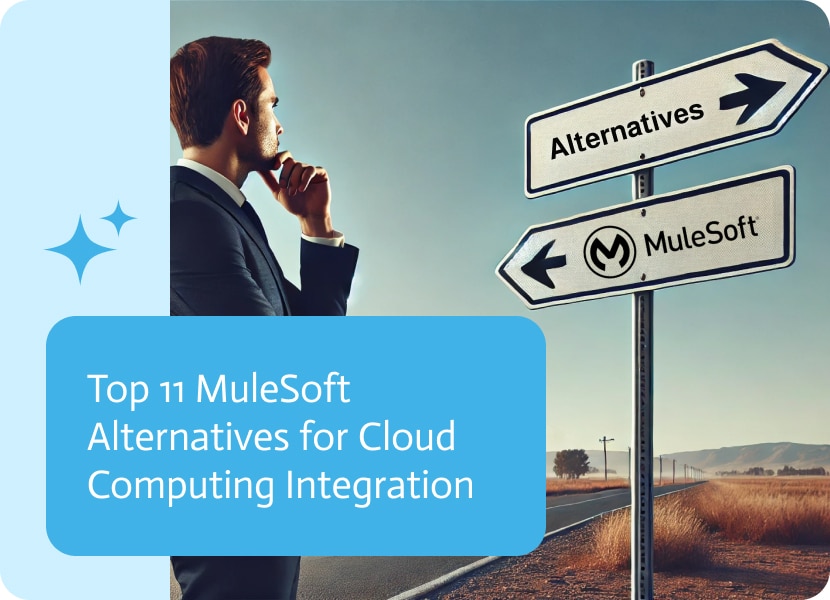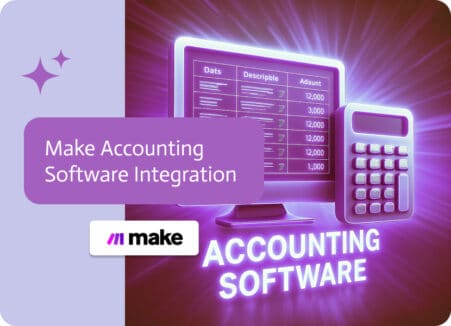

Top 11 MuleSoft Alternatives for Cloud Computing Integration
Integrating cloud computing infrastructure with other business applications is essential for optimizing operations, improving data accuracy, and enhancing decision-making. MuleSoft has been a trusted solution for many organizations, but several alternatives offer unique capabilities and advantages. Here, we explore the top 11 MuleSoft alternatives for cloud computing and infrastructure integration, focusing on real-life use cases, and the benefits and challenges of each platform.
Using MuleSoft for Cloud Computing and Infrastructure Integration
MuleSoft has been a reliable solution for businesses looking to streamline their cloud computing and infrastructure integrations. Its robust API management capabilities, extensive app support, and advanced workflow creation tools have made it a preferred choice for connecting various cloud services and infrastructure tools with other enterprise applications.
Real-Life Use Cases
- Hybrid Cloud Management: A large enterprise uses a hybrid cloud environment combining AWS and Azure. They need to synchronize data and manage workloads between the two cloud platforms. MuleSoft enables them to create workflows that automate data transfer, workload distribution, and provide real-time monitoring across the hybrid cloud setup.
- DevOps Automation: A tech company utilizes multiple tools like Jenkins, GitHub, and Docker for their DevOps processes. The use MuleSoft Devops integration which helps integrate these tools, automating CI/CD pipelines, monitoring code changes, and deploying applications seamlessly across different environments.
- Cloud Security Management: A financial institution needs to ensure compliance and security across its cloud infrastructure. MuleSoft integrates their cloud security tools, automating threat detection, compliance checks, and incident responses to maintain a secure and compliant cloud environment.
MuleSoft Benefits
- Comprehensive Integrations: Supports numerous cloud services and infrastructure tools.
- User-Friendly Interface: Intuitive workflow creation tools that simplify complex processes.
- Advanced Automation Features: Capable of managing intricate workflows and data transformations.
MuleSoft Challenges
- Initial Setup Complexity: May require considerable technical expertise for the initial setup.
- Pricing: Can be costly, particularly for small to mid-sized enterprises.
- Maintenance: Ongoing maintenance may need continuous technical support.
With MuleSoft’s capabilities outlined, let’s dive into the top 11 MuleSoft alternatives that offer unique features and benefits for cloud computing and infrastructure integration.
1. Noca AI
Noca AI stands out with its AI-first and NLP-driven approach, setting it apart from other MuleSoft alternatives. Unlike traditional integration platforms that require extensive coding and technical expertise, Noca AI leverages natural language processing (NLP) to enable users to create complex integrations simply by describing their needs in plain English.
Real-Life Use Case: Comparing MuleSoft and Noca AI
Consider a tech company that needs to integrate multiple cloud services, including AWS, Google Cloud, and Azure, with their DevOps tools like Jenkins and Docker. Using MuleSoft, they would need to configure detailed workflows manually, requiring significant technical expertise and time. In contrast, with Noca AI, the company’s DevOps manager can simply describe the integration requirements in natural language, such as “sync AWS S3 data with Google Cloud Storage daily and trigger Jenkins builds.” Noca AI then automatically generates and optimizes the workflow, reducing setup time and making the process accessible to non-technical users.
Noca AI Benefits
- User-Friendly: No coding skills required, thanks to NLP.
- Efficiency: Rapid deployment and real-time updates.
- Scalability: Supports growing integration needs as businesses expand.
- Advanced Analytics: Provides real-time insights into cloud data.
- Security: Ensures data protection and compliance with industry standards.
2. AWS Step Functions
AWS Step Functions is a serverless orchestration service that lets you combine AWS services to build and scale complex applications.
Benefits
- Serverless Architecture: Reduces the need for server management.
- Seamless AWS Integration: Easily integrates with other AWS services.
- Scalability: Automatically scales to handle varying loads.
Challenges
- AWS Dependency: Best suited for AWS-centric environments.
- Learning Curve: Requires understanding of AWS services.
- Cost: Can become expensive with extensive usage.
3. Google Cloud Composer
Google Cloud Composer is a fully managed workflow orchestration service built on Apache Airflow, making it a viable MuleSoft alternative for Cloud Computing Integration.
Benefits
- Managed Service: Reduces operational overhead.
- Integration with Google Cloud: Seamlessly connects with Google Cloud services.
- Open Source: Built on Apache Airflow, providing flexibility and community support.
Challenges
- Complexity: Advanced features may require technical expertise.
- Cost: Pricing can be high for large-scale workflows.
- Customization: May require additional effort for specific needs.
4. Microsoft Azure Logic Apps
Azure Logic Apps helps you automate workflows and integrate apps, data, and services across organizations, standing out as a strong MuleSoft alternative for Cloud Computing Integration.
Benefits
- Wide Range of Connectors: Supports numerous applications and services.
- Scalability: Handles large-scale integrations efficiently.
- User-Friendly: Visual designer simplifies workflow creation.
Challenges
- Complexity: Advanced features may require technical expertise.
- Cost: Can be expensive for extensive use cases.
- Learning Curve: Requires familiarity with Azure services.
5. IBM Cloud Pak for Integration
IBM Cloud Pak for Integration provides a comprehensive solution for integrating apps, data, and APIs across multiple clouds.
Benefits
- Comprehensive Integration: Supports various integration scenarios.
- Enterprise-Grade Security: Ensures compliance and data protection.
- AI-Powered: Utilizes AI for intelligent automation.
Challenges
- Complexity: Requires significant technical expertise.
- Cost: High pricing for enterprise solutions.
- Setup Time: Initial setup can be time-consuming.
6. Boomi
Boomi, by Dell Technologies, offers a cloud-native platform that emphasizes speed and ease of use for integrating cloud services and infrastructure tools.
Benefits
- Unified Platform: Combines integration, data management, and API management.
- Pre-Built Connectors: Simplifies connecting various applications.
- Low-Code Interface: Allows rapid integration development.
Challenges
- Cost: Can be pricey for smaller organizations.
- Complexity: May require significant technical expertise and setup time.
- Customization: May need additional customization for specific requirements.
7. Jitterbit Harmony
Jitterbit Harmony is known for its quick integration setup and user-friendly interface, making it a good MuleSoft alternative for cloud computing integrations.
Benefits
- Ease of Use: Minimal coding required.
- Versatile Integration: Supports a wide range of applications and services.
Challenges
- Limited Customization: May not cater to highly specific requirements.
- Cost: Can be expensive for larger integrations.
- Scalability: May struggle with extremely high volumes of transactions.
8. Talend Cloud
Talend Cloud offers powerful data integration tools with a focus on big data and cloud integration, presenting itself as a viable MuleSoft alternative.
Benefits
- Data Management: Advanced features for data quality and governance.
- Open Source Options: Provides a free open-source version for basic integrations.
- Scalability: Suitable for both small and large enterprises.
Challenges
- Learning Curve: Can be challenging for non-technical users.
- Cost: The enterprise version can be expensive.
- Resource Intensive: May require significant system resources to run efficiently.
9. SnapLogic
SnapLogic offers a platform designed to connect applications, data, and APIs seamlessly, making it a competitive MuleSoft alternative.
Benefits
- Scalability: Handles large-scale integrations efficiently.
- Ease of Use: Intuitive interface for building integrations.
Challenges
- Complexity: Advanced features may require technical expertise.
- Cost: Can be high for extensive use cases.
- Customization: May require additional effort for highly specific needs.
10. Tray.io
Tray.io provides a powerful, flexible platform for integrating cloud applications and automating workflows, making it a noteworthy MuleSoft alternative.
Benefits
- Low-Code Platform: Simplifies integration development.
- Scalability: Suitable for both small and large enterprises.
- Extensive Connector Library: Supports numerous applications and services.
Challenges
- Learning Curve: May require time to master advanced features.
- Cost: Can be expensive for extensive use cases.
- Customization: May need additional effort for specific requirements.
11. Workato
Workato has been a reliable solution for businesses looking to streamline their cloud computing and infrastructure integrations.
Benefits
- Unified Platform: Combines integration, data management, and API management.
- Pre-Built Connectors: Simplifies connecting various applications.
- Low-Code/no-code Interface: Allows rapid integration development.
Challenges
- Cost: Can be pricey for smaller organizations.
- Complexity: May require significant technical expertise and setup time.
- Customization: May need additional customization for specific requirements.
Conclusion
Selecting the optimal integration platform for your cloud computing and infrastructure is essential for enhancing business efficiency and ensuring data accuracy. While MuleSoft (using the Anypoint platform) has proven to be a reliable option, exploring alternatives like Noca AI can provide distinct benefits, particularly with its AI-driven and NLP-based approach that simplifies the integration process for everyone, regardless of technical expertise. By carefully assessing your business’s specific requirements and weighing the pros and cons of each MuleSoft alternative, you can make a well-informed choice that fully leverages the potential of your cloud infrastructure.
Frequently Asked Questions (FAQs)
Q1: What factors should I consider when choosing a cloud computing and infrastructure integration platform?
When choosing a cloud computing and infrastructure integration platform, consider factors such as ease of use, scalability, cost, security features, and the ability to handle complex workflows. It’s also important to evaluate the platform’s compatibility with your existing cloud services and infrastructure tools.
Q2: How can integration platforms improve cloud infrastructure management?
Integration platforms can streamline cloud infrastructure management by automating data transfer between systems, reducing manual data entry, and ensuring data consistency. This leads to more efficient resource management, better compliance with regulations, improved data management, and enhanced monitoring capabilities.
Q3: What are the common challenges faced during cloud integration, and how can they be mitigated?
Common challenges during cloud integration include data compatibility issues, system downtime, high costs, and user resistance to change. To mitigate these challenges, businesses should plan thoroughly, ensure data quality, choose a reliable integration platform, and provide adequate training for users. Engaging stakeholders early and maintaining open communication throughout the integration process can also help address potential issues.

